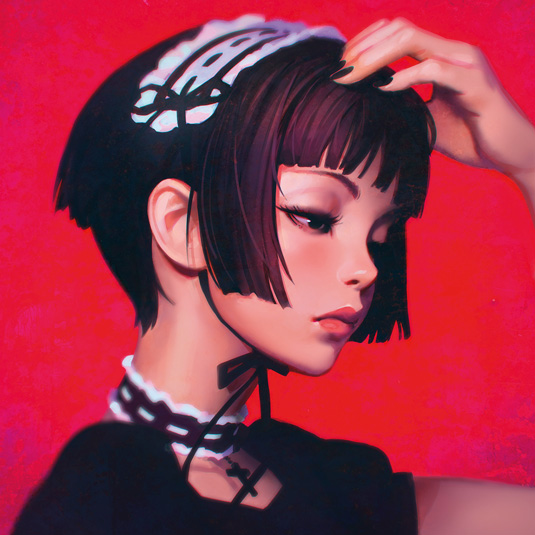Should you be jumping on the crowdfunding bandwagon?
More artists are using crowdfunding sites like Patreon and Gumroad to make their art careers sustainable.

Freelance illustrator and comic artist Ilya Kuvshinov earns $3,129.85 every week through crowdfunding platform Patreon. That's right. $3,129.85. Per week.
The Russia-born, Japan-based artist only joined the site in November 2014, but it's already become his sole source of income, and he's not the only one at it. Digital artist Paul Kwon, aka ZeroNis, has 1,237 patrons who donate $6,269.53 every fortnight. And Canadian fantasy artist Sakimichan pulls in a whopping $28,421.57 fortnightly, thanks to the support of some 3,432 patrons.
Patreon is one of several new platforms that enable creators to fund their projects via donations from supporters – or 'patrons', in this case. Unlike Kickstarter, where a successful campaign leads to a single sum, Patreon is a subscription model: fans pledge a fee per artwork or on a recurring basis, in return for exclusive content.

"Thanks to Patreon, I can do – draw – what I like. I don't need to take boring or uninteresting commissions just because I need to eat everyday," says Ilya, who offers his donors a tiered reward system. For pledges of $1 or more per week, fans receive 10 pictures every week, plus behind-the-scenes sketches. For $5 or more, patrons also get Photoshop documents and full-size imagery, while for $10 or more process videos are added to the mix.
Milestone goals give artists the opportunity to further thank their fans when specific targets – earning $1,000 per week, for example – are reached. However, these commitments can prove challenging, and not just because of time constraints. A common observation from new users is that it can be tricky to know exactly what sort of incentives will best encourage patrons to pledge.

"It's easier now, though," says Ilya, "because they're commenting about what they want to see – tutorials, for instance. Tutorials can be hard, because I'm still learning myself. But if you have passion and love what you do, it attracts people."
"The people who don't see much success lack strong content, consistency and point of view," says multimedia artist and toy designer Chris Ryniak, who provides his 139 patrons with behind-the-scenes studio updates, news, secret sales and more. "It's not a model that will work for everyone, that’s for sure."
Daily design news, reviews, how-tos and more, as picked by the editors.
Eager customers

For artists who already have a large following, however, direct-to-fan sites such as Patreon, Kickstarter and Gumroad – the latter being a platform that enables creators to rent or sell digital assets straight to consumers – are a no-brainer. After all, there's little need for a costly middleman when an engaged community is actively waiting for you to create your next piece of art or content.
Jason Seiler is an illustrator specialising in caricature and portraits for publications such as Rolling Stone and The New Yorker. He's been selling video tutorials alongside his work on Gumroad since the autumn of 2014, and generates interest through social media for each new tutorial by sharing trailers and links with his 153,000 Facebook fans and Instagram followers.

"I've been an instructor at Schoolism.com for 10 years now and figured that I could use the Gumroad site as a way to get more students to sign up for my Schoolism class," says Jason. "The videos are a way to share some of what I teach for a fair price, and then if you want more you can sign up for my class."
To make real cash on crowd-funding sites, however, artists need to invest serious time into the platforms. "When a video first comes out," says Jason, "I can do quite well for a couple weeks. But it's not a realistic way to make serious money. For me, it's just a little extra cash here and there. If I wanted to make Gumroad my full income, I'd have to put more energy and time into."

Artists also need to be aware of tax issues. From 1 January 2015, a new regulation means VAT on digital products sold in the EU is chargeable in the place of purchase, rather than the place of supply. VATMOSS (VAT Mini One Stop Shop) aims to prevent huge companies diverting sales through low-VAT countries like Luxembourg. But the new rules apply equally to creatives.
"The seller is responsible both for charging the correct taxes and remitting them to that national tax authority through VATMOSS," says Heather Burns, a Glasgow-based web designer and digital law specialist. Because many creative platforms are located outside the EU, there are unanswered questions about how these are expected to comply.
Too small to be taxed?

"With so much uncertainty about the law and its future, creatives must find out whether their platform is VATMOSS compliant," says Heather. "If it isn't, you're exposed to a massive administrative and taxation burden." She reveals that the EU Vat Action campaign has reported European tax authorities chasing artists outside the EU over VATMOSS discrepancies of less than €5. "No creative should think they are too small to be caught out."
It's 'win' all around: artists are supported by their fans, and fans enable their favourite artists to give them more of what they love
So, will crowdfunding platforms continue to provide a sustainable source of income? For now, yes. According to Massolution's 2015CF – Crowdfunding Industry Report, global crowdfunding in 2014 expanded by 167 per cent, reaching $16.2 billion in contributions, up from $6.1 billion in 2013.
"I think that removing the middleman can, in some instances, be for the best," reflects world-renowned fantasy artist Todd Lockwood. He’s launching a Kickstarter campaign in autumn this year for a new art collection book. "It's 'win' all around: artists are supported by their fans, and fans enable their favourite artists to give them more of what they love."

Chris agrees with Todd: "As long as there are creators generating content that people care about, and those creators tend to their communities, I think people will want to feel like they're doing their part," he says. "Since contributions are generally low, donors don’t feel pinched."
"I'm pleased with what I have to offer and feel confident that people feel the same," says Jason. "I want to inspire people and get them excited to draw. Hopefully that’s enough to keep people interested."
This is article originally appeared in ImagineFX issue 125.
Like this? Read these!

Julia is editor-in-chief, retail at Future Ltd, where she works in e-commerce across a number of consumer lifestyle brands. A former editor of design website Creative Bloq, she’s also worked on a variety of print titles, and was part of the team that launched consumer tech website TechRadar. She's been writing about art, design and technology for over 15 years.
